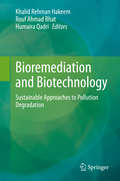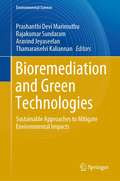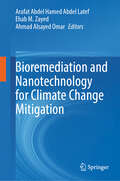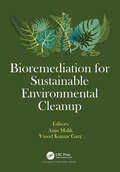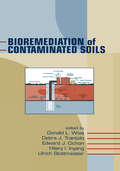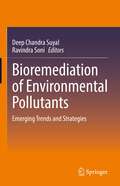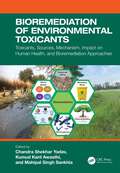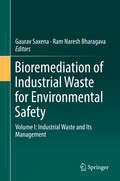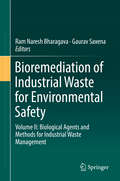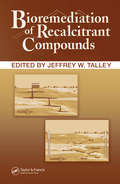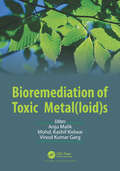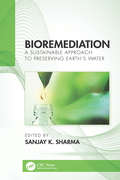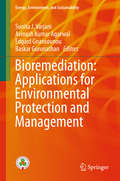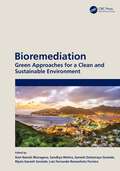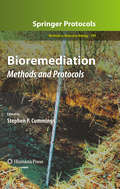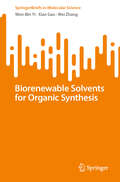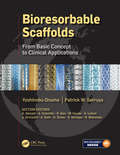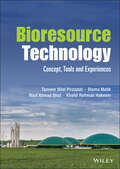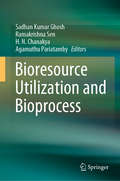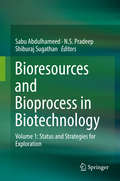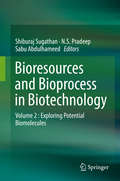- Table View
- List View
Bioremediation and Biotechnology: Sustainable Approaches to Pollution Degradation
by Khalid Rehman Hakeem Humaira Qadri Rouf Ahmad BhatToxic substances threatens aquatic and terrestrial ecosystems and ultimately human health. The book is a thoughtful effort in bringing forth the role of biotechnology for bioremediation and restoration of the ecosystems degraded by toxic and heavy metal pollution. The introductory chapters of the book deal with the understanding of the issues concerned with the pollution caused by toxic elements and heavy metals and their impacts on the different ecosystems followed by the techniques involved in monitoring of the pollution. These techniques include use of bio-indicators as well as modern techniques for the assessment and monitoring of toxicants in the environment. Detailed chapters discussing the role of microbial biota, aquatic plants, terrestrial plants to enhance the accumulation efficiency of these toxic and heavy metals are followed by remediation techniques involving myco-remediation, bio-pesticides, bio-fertilizers, phyto-remediation and rhizo-filtration. A sizable portion of the book has been dedicated to the advanced bio-remediation techniques which are finding their way from the laboratory to the field for revival of the degraded ecosystems. These involve bio-films, micro-algae, genetically modified plants and filter feeders. Furthermore, the book is a detailed comprehensive account for the treatment technologies from unsustainable to sustainable. We believe academicians, researchers and students will find this book informative as a complete reference for biotechnological intervention for sustainable treatment of pollution.
Bioremediation and Green Technologies: Sustainable Approaches to Mitigate Environmental Impacts (Environmental Science and Engineering)
by Rajakumar Sundaram Aravind Jeyaseelan Thamaraiselvi Kaliannan Prashanthi Devi MarimuthuThis book offers insights into the recent research focusing on green solutions to address environmental pollution and its impacts. Bioremediation is a vast area that encompasses numerous innovative and cost-effective experimental and research methods involvingnumerous technologies, such as biotechnological, biochemical, microbial, marine, chemical and engineering approaches. Featuring original research and review articles by leading experts, the book explores potential solutions to the growing issues of waste management and environmental pollution and their impacts, and suggests future research directions. As such, it is a valuable resource for professionals and general readers alike.
Bioremediation and Nanotechnology for Climate Change Mitigation
by Arafat Abdel Hamed Abdel Latef Ehab M. Zayed Ahmad Alsayed OmarThis book integrates various scientific approaches, including bioremediation and nanomaterials, to address environmental challenges posed by living organisms. It serves as a crucial guide for decision-makers, providing a scientific foundation for tackling issues within the circular economy paradigm. By introducing innovative methods for improving environmental conditions, the book facilitates the design of eco-friendly cities and revitalizes older urban areas. The chapters cover topics such as the current state and future of international environmental relations, the impact of population growth on pollution, and recent advances in sustainable waste management. Readers will discover insights into the relationship between air pollution, nanomaterials, and bioremediation, as well as the role of artificial intelligence as a predictive tool. The book also explores key pollution-related issues and presents effective remediation strategies. Special attention is given to the role of nanotechnology in addressing climate change, with chapters highlighting its applications in sustainable agriculture. This book is an invaluable resource for professionals, researchers, and graduate students engaged in advanced environmental science research. It reinforces fundamental remediation concepts while introducing the latest updates, maximizing readers' knowledge of sensor-based remediation. The book presents a multidisciplinary approach, integrating theoretical perspectives with practical case studies. Whether the reader is an academic, practitioner, or interested layperson, this book offers a wealth of information and insights into the future of environmental sustainability.
Bioremediation and Sustainability: Research and Applications
by Ackmez Mudhoo Romeela MoheeBioremediation and Sustainability is an up-to-date and comprehensive treatment of research and applications for some of the most important low-cost, "green," emerging technologies in chemical and environmental engineering.
Bioremediation for Sustainable Environmental Cleanup
by Vinod Kumar Garg Anju MalikThe present book, Bioremediation for Sustainable Environmental Cleanup, has a compilation of seventeen chapters comprehensively describing the state-of-the-art on emerging bioremediation approaches employed for sustainable environmental clean-up of diverse environmental pollutants such as metal(loid)s, polycyclic aromatic hydrocarbons, dyes, pesticides, petroleum hydrocarbons, etc., by using bacteria, fungi, algae, higher plants, and novel materials like biohybrids, nano-biomaterials, and graphitic carbon nitride (g-C3N4). Different bioremediation strategies such as biosorption, bioprecipitation, bioaccumulation, biodegradation, biotransformation etc. have been described in detail. The emphasis throughout, however, is on sustainable environmental clean-up. Eminent researchers from various countries located in diverse geographical areas, including Argentina, Canada, Germany, India, Pakistan, South Africa, the United Kingdom, and the United States of America, have contributed towards the chapters of this book.
Bioremediation of Agricultural Soils
by Juan C. Sanchez-HernandezThe quality of agricultural soils are always under threat from chemical contaminants, which ultimately affect the productivity and safety of crops. Besides agrochemicals, a new generation of substances invades the soil through irrigation with reclaimed wastewater and pollutants of organic origin such as sewage sludge or cattle manure. Emerging pollutants such as pharmaceuticals, nanomaterials and microplastics are now present in agricultural soils, but the understanding of their impact on soil quality is still limited. With focus on in situ bioremediation, this book provides an exhaustive analysis of the current biological methodologies for recovering polluted agricultural soils as well as monitoring the effectiveness of bioremediation.
Bioremediation of Aquatic and Terrestrial Ecosystems
by Milton FingermanBioremediation, the use of microorganisms to degrade, sequester, or remove environmental contaminants, is an urgent need of our planet for protection and restoration from toxic contaminants. This book not only provides cutting edge information about bioremediation of aquatic and terrestrial habitats, but also highlights the gaps in our knowledge of
Bioremediation of Contaminated Soils (Environmental Science & Pollution)
by Donald L. WiseThis volume focuses on innovative bioremediation techniques and applications for the cleanup of contaminated media and sites. It includes quantitative and design methods that elucidate the relationships among various operational parameters, and waste chemistry that defines the cost effectiveness of bioremediation projects. It also presents numerica
Bioremediation of Environmental Pollutants: Emerging Trends and Strategies
by Ravindra Soni Deep Chandra SuyalThis book collates the latest trends and technological advancements in bioremediation, especially for its monitoring and assessment.Divided into 18 chapters, the book summarizes basic concepts of waste management and bioremediation, describes advancements of the existing technologies, and highlights the role of modern instrumentation and analytical methods, for environmental clean-up and sustainability.The chapters cover topics such as the role of microbial fuel cells in waste management, microbial biosensors for real-time monitoring of bioremediation processes, genetically modified microorganisms for bioremediation, application of immobilized enzyme reactors, spectroscopic techniques, and in-silico approaches in bioremediation monitoring and assessment. The book will be advantageous not only to researchers and scholars interested in bioremediation and sustainability but also to professionals and policymakers.
Bioremediation of Environmental Toxicants: Toxicants, Sources, Mechanism, Impact on Human Health, and Bioremediation Approaches
by Kumud Kant Awasthi Mahipal Singh Sankhla Chandra Shekhar YadavBioremediation of Environmental Toxicants: Toxicants, Sources, Mechanism, Impact on Human Health, and Bioremediation Approaches provides insight into the nature of environmental toxicants, the impact on human health, and their bioremediation approaches, viz. nanotechnology, microorganism, and phytoremediation. Various environmental toxicants such as pesticides, heavy metals, plastic and microplastic waste, dyes used in industries, colorants, corrosive agents, and biomedical waste show different levels of mechanism of toxicity, possessing a significant threat to human health as well as the stability of ecosystems. To decontaminate the environment from these toxic compounds a low-cost effective technique is required. Bioremediation is a sustainable approach by which hazardous pollutants are converted into less harmful or non-toxic compounds using effective techniques to detoxify contaminated soil and water. In recent years, research has steadily concentrated on the various bioremediation approaches, viz. nanoparticle, microorganism, and phytoremediation.KEY FEATURES Showcases contributions from high-profile experts in the field Highlights the current state and importance of environmental bioremediation Provides detailed knowledge about the mechanism, toxicity, and action of environmental toxicants Furnishes a deep understanding of environment–human interaction and the after effects Outlines the state-of-the-art bioremediation technologies, viz. nanotechnology, microbial- and plant-based mitigation of environmental toxicants
Bioremediation of Industrial Waste for Environmental Safety: Volume I: Industrial Waste and Its Management
by Ram Naresh Bharagava Gaurav SaxenaAchieving environmental sustainability with rapid industrialization is a major challenge of current scenario worldwide. As globally evident, industries are the key economic drivers, but are also the major polluters as untreated/partially treated effluents discharged from the industries is usually thrown into the aquatic resources and also dumped unattended. Industrial effluents are considered as the major sources of environmental pollution as these contains highly toxic and hazardous pollutants, which reaches far off areas due to the medium of dispersion and thus, create ecological nuisance and health hazards in living beings. Hence, there is an urgent to find ecofriendly solution to deal with industrial waste, and develop sustainable methods for treating/detoxifying wastewater before its release into the environment. Being a low cost and eco-friendly clean technology, bioremediation can be a sustainable alternative to conventional remediation technologies for treatment and management of industrial wastes to protect public health and environment. Therefore, this book (Volume I) covers the bioremediation of different industrial wastes viz. tannery wastewater, pulp and paper mill wastewater, distillery wastewater, acid mine tailing wastes, and many more; which are lacking in a comprehensive manner in previous literature at one place. A separate chapter dedicated to major industries and type of waste produced by them is also included. This book will appeal to students, researchers, scientists, industry persons and professionals in field of microbiology, biotechnology, environmental sciences, eco-toxicology, environmental remediation and waste management and other relevant areas, who aspire to work on the biodegradation and bioremediation of industrial wastes for environmental safety.
Bioremediation of Industrial Waste for Environmental Safety: Volume II: Biological Agents and Methods for Industrial Waste Management
by Ram Naresh Bharagava Gaurav SaxenaAchieving environmental sustainability with rapid industrialization is currently a major global challenge. Industries are the key economic drivers, but are also the main polluters as untreated/partially treated effluents from industry are usually discharged into the aquatic environment or dumped. Industrial effluents often contain highly toxic and hazardous pollutants, which cause ecological damage and present and health hazards to living beings. As such, there is a pressing need to find ecofriendly solutions to deal with industrial waste, and to develop sustainable methods for treating/detoxifying waste before it’s released into the environment. As a low cost and eco-friendly clean technology, bioremediation can offer a sustainable alternative to conventional remediation technologies for the treatment and management of industrial wastes. This book (Volume II) describes the role of biological agents in the degradation and detoxification of organic and inorganic pollutants in industrial wastes, and presents recent bioremediation approaches for waste treatment and management, such as constructed wetlands, electro- bioremediation and nano-bioremediation, as well as microbial fuel cells. It appeals to students, researchers, scientists, industry professionals and experts in the field of microbiology, biotechnology, environmental sciences, eco-toxicology, environmental remediation and waste management and other relevant areas who are interested in biodegradation and bioremediation of industrial wastes for environmental safety.
Bioremediation of Recalcitrant Compounds
by Jeffrey W. TalleyThis authoritative text addresses the latest in bioremediation technologies for three difficult-to-treat contaminant groups: chlorinated solvents, PCBs, and PAHs - one of the most complex and expensive areas of applied remediation engineering.Bioremediation of Recalcitrant Compounds assesses innovative R&D projects developed for each contam
Bioremediation of Toxic Metal(loid)s
by Vinod Kumar Garg Anju Malik Mohd Kashif KidwaiThe book, Bioremediation of Toxic Metal(loid)s, describes the state-of-the-art and potential of emerging technologies on bioremediation of toxic metal(loid)s. It has a compilation of the available comprehensive knowledge of the fundamentals and advancements in the field of bioremediation of toxic metal(loid)s. The mechanisms, applications, and current advancements of various bioremediation strategies used for metal(loid)s have been described in 21 chapters contributed by leading experts from different institutes, universities, and research laboratories from various countries across the globe including Argentina, Canada, Chile, Colombia, France, India, Japan, Republic of Korea, the United Kingdom, and the United States of America. This book offers a bird’s eye view on various bioremediation technologies based on a variety of biological agents viz. plants, bacteria, algae, fungi etc., used for environmental clean-up of toxic metal(loid)s.
Bioremediation using weeds (Energy, Environment, and Sustainability)
by Deepak Pant Shashi Kant Bhatia Anil K. Patel Anand GiriIn this monograph, the core elements of multidisciplinary bioremediation practices are addressed and environmental pollutants which can be effectively remediated using weeds is focused upon. Weeds plants can easily grow in waste dumping sites with their rapidly colonizing ability. The contents include recent results in bioremediation and focuses on the current trend of introduction of potentials of weeds in bioremediation practice. This volume will be a useful guide for researchers, academics and scientists.^
Bioremediation: A Sustainable Approach to Preserving Earth’s Water
by Sanjay K. SharmaBioremediation: A Sustainable Approach to Preserving Earth’s Water discusses the latest research in green chemistry practices and principles that are involved in water remediation and the quality improvement of water.The presence of heavy metals, dyes, fluoride, dissolved solids and many other pollutants are responsible for water pollution and poor water quality. The removal of these pollutants in water resources is necessary, yet challenging. Water preservation is of great importance globally and researchers are making significant progress in ensuring this precious commodity is safe and potable. This volume illustrates how bioremediation in particular is a promising green technique globally.Features: Addresses bioremediation of all the major water pollutants Approaches the chemistry of water and the concept of water as a renewable resource from a green chemistry aspect Discusses environmental chemistry and the practice of industrial ecology Explains the global concern of adequate high quality water supplies, and how bioremediation can resolve this Explores sustainable development through green engineering
Bioremediation: Applications For Environmental Protection And Management (Energy, Environment, and Sustainability)
by Avinash Kumar Agarwal Sunita J. Varjani Edgard Gnansounou Baskar GurunathanThis book examines bioremediation technologies as a tool for environmental protection and management. It provides global perspectives on recent advances in the bioremediation of various environmental pollutants. Topics covered include comparative analysis of bio-gas electrification from anaerobic digesters, mathematical modeling in bioremediation, the evaluation of next-generation sequencing technologies for environmental monitoring in wastewater abatement; and the impact of diverse wastewater remediation techniques such as the use of nanofibers, microbes and genetically modified organisms; bioelectrochemical treatment; phytoremediation; and biosorption strategies. The book is targeted at scientists and researchers working in the field of bioremediation.
Bioremediation: Green Approaches for a Clean and Sustainable Environment
by Ram Naresh BharagavaEnvironmental sustainability with rapid industrialization is one of the current major global challenges. Industries are the key drivers of the world economy. But they are also the major polluters of the environment due to the discharge of partially treated/untreated toxic and hazardous wastes containing organic and inorganic pollutants, which cause severe environmental (soil and water) pollution and toxic effects in living beings. So the adequate treatment of industrial wastes to degrade/detoxify pollutants is of the utmost importance for environmental safety and for promoting the sustainable development of our society with low environmental impacts. Bioremediation: Green Approaches for a Clean and Sustainable Environment showcases the latest information on the different bioremediation approaches used for the many types of industrial pollutants and are dedicated to environmental safety. This book provides a detailed knowledge about the natural as well as anthropogenic sources of different types of toxic pollutants, such as toxic metals, dyes, pesticides, petroleum hydrocarbons and plastics; their fate and transport into the environment; their ecotoxicological effects and health hazards; and different approaches used for their bioremediation for the environmental clean-up. Key Features: Covers the different aspects of environmental problems and their remedies with up-to-date developments in the field of bioremediation of industrial/environmental pollutants Serves as an invaluable source of knowledge for a wide range of students, scientists, and researchers in microbiology, biotechnology, environmental sciences with the fundamental and advanced knowledge about the environmental pollution, challenges, and bioremediation of toxic pollutants
Bioremediation: Methods and Protocols (Methods in Molecular Biology #599)
by Stephen P. CummingsSince its first systematic application during the 1970s, bioremediation, or the exploitation of a biological system's degradative potential to combat toxic pollutants such as heavy metals, polyaromatic hydrocarbons (PAH), cyanides, and radioactive material, has proven itself over time, and the many advances in molecular techniques have only amplified its utility. In Bioremediation: Methods and Protocols, experts in the field explore imaginative and ambitious multidisciplinary techniques that will enable more predictable removal of pollutants from a variety of environments. The easy-to-follow volume addresses some of the broader issues such as the effect of the environment in determining the availability and fate of organic and inorganic compounds and how choices around the most appropriate bioremediation process can be arrived at, as well as detailed complementary techniques that support the effective deployment and monitoring of a bioremediation approach. Written in the highly successful Methods in Molecular BiologyTM series format, chapters include introductions to their respective topics, lists of the necessary materials and reagents, step-by-step, readily reproducible protocols, and notes on troubleshooting and avoiding known pitfalls. Authoritative and cutting-edge, Bioremediation: Methods and Protocols offers researchers a series of invaluable techniques certain to enhance their work with environmental contamination.
Biorenewable Solvents for Organic Synthesis (SpringerBriefs in Molecular Science)
by Wei Zhang Wen-Bin Yi Xiao GaoIn this brief the authors introduce a series of recently developed bio-based solvents including cyclopentyl methyl ether (CPME), γ-valerolactone (GVL), 2-methyl tetrahydrofuran (2-MeTHF), propylene carbonate (PC), and cyrene. Traditional organic solvents used for organic synthesis (such as benzene, ether, chloroform) have a series drawbacks on toxicity, environmental impact, and safely related issues. In addition, the fossil fuel-derived organic solvents are not sustainable. Therefore the development of biorenewable solvents is a topic of current interest. For each of the solvents, their production, toxicity profile, renewable pathway, and their utility in organic synthesis, biosynthesis, and separation processes is discussed. The target audiences of this book are organic and medicinal chemists with interests in using green solvents. It can also be used as a reference for undergraduate and graduate courses related to organic and green chemistry.
Bioresorbable Scaffolds: From Basic Concept to Clinical Applications
by Yoshinobu Onuma Patrick W.J.C. SerruysThis book focuses on the coronary bioresorbable scaffold, a new interventional treatment for coronary artery disease, differentiated from a permanent metallic stent. The book provides an overview of the technology including non-clinical studies and clinical evidences in order to help clinicians understand the appropriate application of the technology and the optimal techniques of implantation. It covers the basics of bioresorbable scaffolds; bench test results; preclinical studies; clinical evidences; and tips and tricks of implantation.
Bioresource Technology: Concept, Tools and Experiences
by Rouf Ahmad Bhat Khalid Rehman Hakeem Tanveer Bilal Pirzadah Bisma MalikBioresource Technology Discover the latest developments in the field of bioresource technology with this practical handbook The management and cultivation of bioresources are critical components of the economic survival of nations. Significantly underexplored, recent advances in bioresource technologies have breathed new life into the research and development of new bioresource techniques and capabilities. In Bioresource Technology: Concept, Tools, and Experiences, a team of distinguished researchers delivers a comprehensive work intended to bridge the gap between field-oriented taxonomists and ecologists and lab-oriented functional and molecular biologists. The book is divided into three sections: food, environment, and energy. In the first part, the authors explore the functional food sector, from green and smart food packaging to nanosensors as diagnostic tools in the food industry. The second part is concerned with the achievement of future energy security through the use of bioresources as energy sources. Finally, the third section discusses sustainable environmental management policies via bioresource use. Readers will also benefit from the inclusion of: A thorough introduction on the recent advances in the technology pertaining to functional food industry to overcome the future food challenges Comprehensive explorations of the art and science of growing microgreens, including their historical background, cultivation practices, quality, and shelf life In-depth examinations of the bioprospecting of bioresources, including bioprospecting in agriculture, chemical industries, and diagnostic applications Provides state-of-the art technologies in the green energy sector to cater for the energy demand of the people, reducing greenhouse gases (GHG) and the reliance on fossil fuels In-depth understanding on the recent advances in the bioresource management policies and sustainable environment Perfect for postgraduate students, research scholars, faculty, and scientists involved in agriculture, plant sciences, environmental sciences, bioenergy, biofuels, molecular biology, and microbiology, Bioresource Technology: Concept, Tools, and Experiences is also an indispensable resource for those working in biochemistry, biotechnology, and food technology.
Bioresource Utilization and Bioprocess
by Sadhan Kumar Ghosh Agamuthu Pariatamby Ramakrishna Sen H. N. ChanakyaThis book focuses on the utilization of bio-resources and their conversion pathways for a sustainable future. Tapping into bio-resources by means of thermochemical and biochemical processes has attracted researchers from all over the world; it is a broad area that has given birth to concepts like the biorefinery, as well as a new stream known as biotechnology. Its scope includes biochemical and microbiological engineering, biocatalysis and biotransformation, biosynthesis and metabolic engineering, bioprocess and biosystem engineering, bioenergy and biorefineries, cell culture and biomedical engineering, food, agricultural and marine biotechnology, bioseparation and biopurification engineering, bioremediation and environmental biotechnology, etc. The book discusses a host of new technologies now being used to tap these resources with innovative bioprocesses. All chapters are based on outstanding research papers selected for and presented at the IconSWM 2018 conference.
Bioresources and Bioprocess in Biotechnology
by Sabu Abdulhameed N. S. Pradeep Shiburaj SugathanThis book is a compilation of articles on various aspects of bioresources and the processes employed for its judicious utilization. Biodiversity and conservation, food security, gene banks and repositories, laws governing biodiversity, bioprospecting, bioresources in traditional medicine and biodiversity mining are some of the important topics covered in the book. The unique contents of the book make it an important source of information for conservation scientists, academics, activists and to those who are actively involved in product oriented research from bioresources.
Bioresources and Bioprocess in Biotechnology
by Sabu Abdulhameed N. S. Pradeep Shiburaj SugathanThis book is a compilation of detailed articles on various products and services that can be derived from bioresources through bioprocess. It offers in-depth discussions and case studies on commercially and therapeutically important enzymes, antimicrobials, anti-cancer molecules and anti-inflammatory substances. It also includes a separate section on emerging trends in bioactive substances research. This unique book is a valuable source of information for biotechnologists and bioprocess experts as well as academics and researchers who are actively involved in product and process development.
